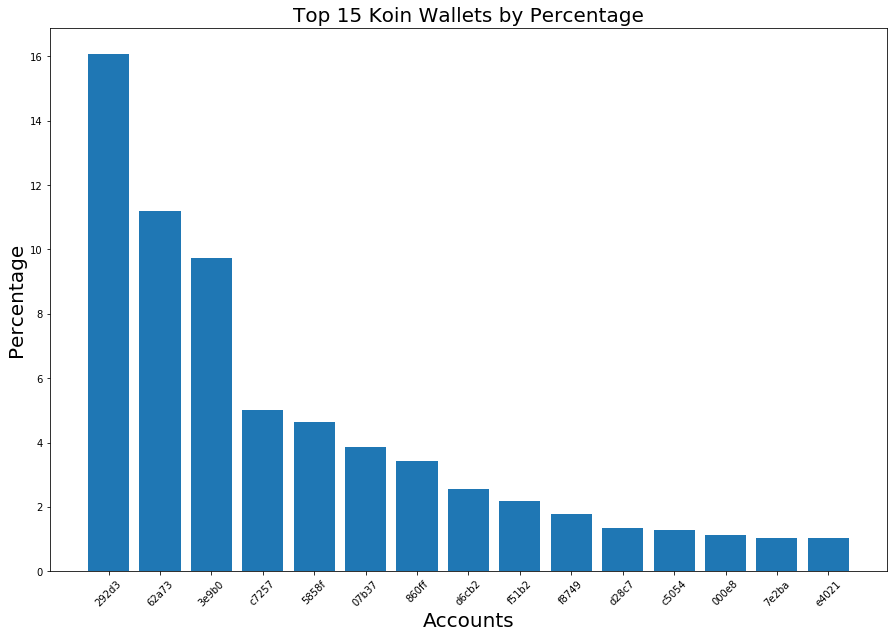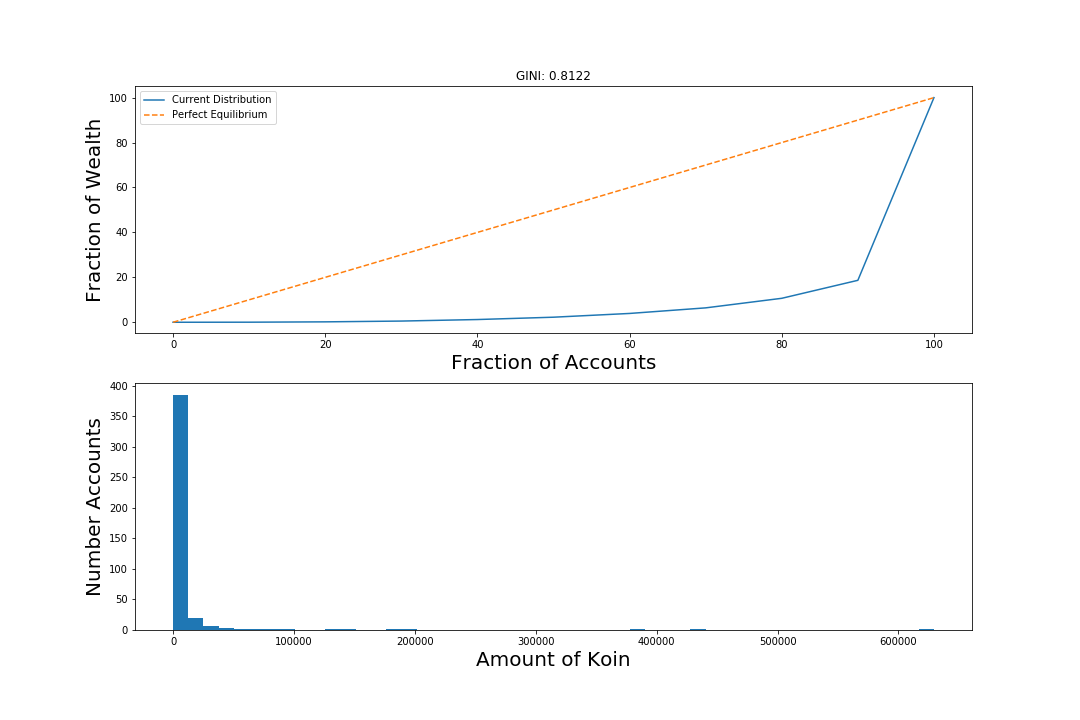Koinos Distribution Report [18.10.2020]
A new blockchain project called Koinos launched on October 13th, 17:00 UTC.
The actual chain is not live, but the team has chosen to launch an ERC-20-Token miner to circulate Koin and achieve initial distribution.
Snapshot data has been taken from etherscan.io on October 18th, 18:50 UTC.
There are 426 addresses holding 3'911'956 Koin.
Percentage distribution among the top 15 addresses:

From a visual inspection of the top 15 accounts, a steep drop among the top addresses can be observed, signifying a very top heavy distribution.
Notes:
- The address currently ranked 3rd, ...3e9b0..., is a Uniswap exchange account to facilitate an ETH/KOIN trading pair.
- Many mining enthusiasts are running more than one miner and might not consolidate all their mined tokens to a single address.
- Addresses truncated for readability.
Statistical Properties
| Stats | Koin Balance Distribution per Address |
|---|---|
| Max | 629'361 |
| Mean | 86'155 |
| Median | 2'490 |
The extremely large difference between mean and median balances also also shows a strong concentration of assets.
Gini Coefficient
As a better measure of distribution, and subsequent changes over time, we can take a look at the Gini coefficient. It is intended as a tool to measure wealth inequality within nations or other groupings. A coefficient of 0 equals a perfect equitable distribution, a value of 1 signifies maximal inequality.

The current data set yields a coefficient of 0,81, signifying a very top heavy distribution.
Herfindahl-Hirshman Index
The Herfindahl–Hirschman Index (HHI) is a measure of industry concentration or competitiveness. Increases in the Herfindahl index generally indicate a decrease in competition. The scale ranges from 0 (highly competitive) to 1 (monopoly). In practice a value over 0,25 already signifies high concentration. This index serves as a second measure to observe how distribution evolves over time.
The current data set yields a value of 0,059.
Summary
The distribution of Koin has just started. Payouts per proof have already plummeted tremendously. The Gini coefficient describes a very unequal distribution, while the HHI is much more benign. These values are starting points which can be referenced in the future to understand if the model of distribution is working as intended.
Vote for my witness: @blue-witness
Koinos Distribution Report [18.10.2020]
A new blockchain project called Koinos launched on October 13th, 17:00 UTC.
The actual chain is not live, but the team has chosen to launch an ERC-20-Token miner to circulate Koin and achieve initial distribution.
Snapshot data has been taken from etherscan.io on October 18th, 18:50 UTC.
There are 426 addresses holding 3'911'956 Koin.
Percentage distribution among the top 15 addresses:
From a visual inspection of the top 15 accounts, a steep drop among the top addresses can be observed, signifying a very top heavy distribution.
Notes:
- The address currently ranked 3rd, ...3e9b0..., is a Uniswap exchange account to facilitate an ETH/KOIN trading pair.
- Many mining enthusiasts are running more than one miner and might not consolidate all their mined tokens to a single address.
- Addresses truncated for readability.
Statistical Properties
| Stats | Koin Balance Distribution per Address |
|---|---|
| Max | 629'361 |
| Mean | 86'155 |
| Median | 2'490 |
The extremely large difference between mean and median balances also also shows a strong concentration of assets.
Gini Coefficient
As a better measure of distribution, and subsequent changes over time, we can take a look at the Gini coefficient. It is intended as a tool to measure wealth inequality within nations or other groupings. A coefficient of 0 equals a perfect equitable distribution, a value of 1 signifies maximal inequality.
The current data set yields a coefficient of 0,81, signifying a very top heavy distribution.
Herfindahl-Hirshman Index
The Herfindahl–Hirschman Index (HHI) is a measure of industry concentration or competitiveness. Increases in the Herfindahl index generally indicate a decrease in competition. The scale ranges from 0 (highly competitive) to 1 (monopoly). In practice a value over 0,25 already signifies high concentration. This index serves as a second measure to observe how distribution evolves over time.
The current data set yields a value of 0,059.
Summary
The distribution of Koin has just started. Payouts per proof have already plummeted tremendously. The Gini coefficient describes a very unequal distribution, while the HHI is much more benign. These values are starting points which can be referenced in the future to understand if the model of distribution is working as intended.
Vote for my witness: @blue-witness
Posted Using LeoFinance Beta
Hmm looks like yet another claim to radical decentralisation can now be called BS!
Posted Using LeoFinance Beta